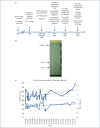Possible clearance of transfusion-acquired nef/LTR-deleted attenuated HIV-1 infection by an elite controller with CCR5 Δ32 heterozygous and HLA-B57 genotype
- PMID: 31191910
- PMCID: PMC6543488
- DOI: 10.1016/S2055-6640(20)30696-11
Possible clearance of transfusion-acquired nef/LTR-deleted attenuated HIV-1 infection by an elite controller with CCR5 Δ32 heterozygous and HLA-B57 genotype
Abstract
Background: Subject C135 is one of the members of the Sydney Blood Bank Cohort, infected in 1981 through transfusion with attenuated nef/3' long terminal repeat (LTR)-deleted HIV-1, and has maintained undetectable plasma viral load and steady CD4 cell count, in the absence of therapy. Uniquely, C135 combines five factors separately associated with control of viraemia: nef/LTR-deleted HIV-1, HLA-B57, HLA-DR13, heterozygous CCR5 Δ32 genotype and vigorous p24-stimulated peripheral blood mononuclear cell (PBMC) proliferation. Therefore, we studied in detail viral burden and immunological responses in this individual.
Methods: PBMC and gut and lymph node biopsy samples were analysed for proviral HIV-1 DNA by real-time and nested PCRs, and nef/LTR alleles by nested PCR. HIV-specific antibodies were studied by Western blotting, and CD4+ and CD8+ T lymphocyte responses were measured by proliferation and cytokine production in vitro.
Results: PBMC samples from 1996, but not since, showed amplification of nef alleles with gross deletions. Infectious HIV-1 was never recovered. Proviral HIV-1 DNA was not detected in recent PBMC or gut or lymph node biopsy samples. C135 has a consistently weak antibody response and a substantial CD4+ T cell proliferative response to a previously described HLA-DR13-restricted epitope of HIV-1 p24 in vitro, which augmented a CD8+ T cell response to an immunodominant HLA-B57-restricted epitope of p24, while his T cells show reduced levels of CCR5.
Conclusions: Subject C135's early PCR and weak antibody results are consistent with limited infection with a poorly replicating nef/LTR-deleted strain of HIV-1. With his HLA-B57-restricted gag-specific CD8 and helper HLA-DR13-restricted CD4 T cell proliferative responses, C135 appears to have cleared his HIV-1 infection 37 years after transfusion.
Keywords: CCR5; CD4; HIV-1; Nef.
Figures





Similar articles
-
Innate and Adaptive Immunity in Long-Term Non-Progression in HIV Disease.Front Immunol. 2013 Apr 24;4:95. doi: 10.3389/fimmu.2013.00095. eCollection 2013. Front Immunol. 2013. PMID: 23630526 Free PMC article.
-
Natural controlled HIV infection: preserved HIV-specific immunity despite undetectable replication competent virus.Virology. 2005 Aug 15;339(1):70-80. doi: 10.1016/j.virol.2005.06.001. Virology. 2005. PMID: 15987650
-
Mechanisms of HIV non-progression; robust and sustained CD4+ T-cell proliferative responses to p24 antigen correlate with control of viraemia and lack of disease progression after long-term transfusion-acquired HIV-1 infection.Retrovirology. 2008 Dec 11;5:112. doi: 10.1186/1742-4690-5-112. Retrovirology. 2008. PMID: 19077215 Free PMC article.
-
An examination of signs of disease progression in survivors of the Sydney Blood Bank Cohort (SBBC).J Clin Virol. 2001 Oct;22(3):263-70. doi: 10.1016/s1386-6532(01)00198-6. J Clin Virol. 2001. PMID: 11564591
-
Human immunodeficiency virus type 1 long-term non-progressors: the viral, genetic and immunological basis for disease non-progression.J Gen Virol. 2011 Feb;92(Pt 2):247-68. doi: 10.1099/vir.0.027102-0. Epub 2010 Nov 24. J Gen Virol. 2011. PMID: 21106806 Review.
Cited by
-
CCR5∆32 and SDF1 3'A: Gene Variants, Expression and Influence on Biological Markers for the Clinical Progression to AIDS among HIV-1 Virus Controllers in a Mixed Population of the Amazon Region of Brazil.Int J Mol Sci. 2023 Mar 4;24(5):4958. doi: 10.3390/ijms24054958. Int J Mol Sci. 2023. PMID: 36902388 Free PMC article.
-
CD8+ T cells in HIV control, cure and prevention.Nat Rev Immunol. 2020 Aug;20(8):471-482. doi: 10.1038/s41577-020-0274-9. Epub 2020 Feb 12. Nat Rev Immunol. 2020. PMID: 32051540 Free PMC article. Review.
-
How elite controllers and posttreatment controllers inform our search for an HIV-1 cure.J Clin Invest. 2021 Jun 1;131(11):e149414. doi: 10.1172/JCI149414. J Clin Invest. 2021. PMID: 34060478 Free PMC article. Review.
-
High titre neutralizing antibodies in response to SARS-CoV-2 infection require RBD-specific CD4 T cells that include proliferative memory cells.Front Immunol. 2022 Dec 5;13:1032911. doi: 10.3389/fimmu.2022.1032911. eCollection 2022. Front Immunol. 2022. PMID: 36544780 Free PMC article.
-
Mechanism of Viral Suppression among HIV Elite Controllers and Long-Term Nonprogressors in Nigeria and South Africa.Viruses. 2022 Jun 10;14(6):1270. doi: 10.3390/v14061270. Viruses. 2022. PMID: 35746741 Free PMC article. Review.
References
-
- Pantaleo G, Koup RA. Correlates of immune protection in HIV-1 infection: what we know, what we don't know, what we should know. Nat Med 2004; 10: 806– 810. - PubMed
-
- Heeney J, Plotkin SA. Immunological correlates of protection from HIV infection and disease. Nat Immunol 2006; 7: 1281– 1284. - PubMed
-
- Walker BD, Yu XG. Unravelling the mechanisms of durable control of HIV-1. Nat Rev Immunol 2013; 13: 487– 498. - PubMed
-
- Hutter G, Nowak D, Mossner M et al. . Long-term control of HIV by CCR5 Delta32/Delta32 stem-cell transplantation. N Engl J Med 2009; 360: 692– 698. - PubMed
Publication types
Grants and funding
LinkOut - more resources
Full Text Sources
Research Materials
